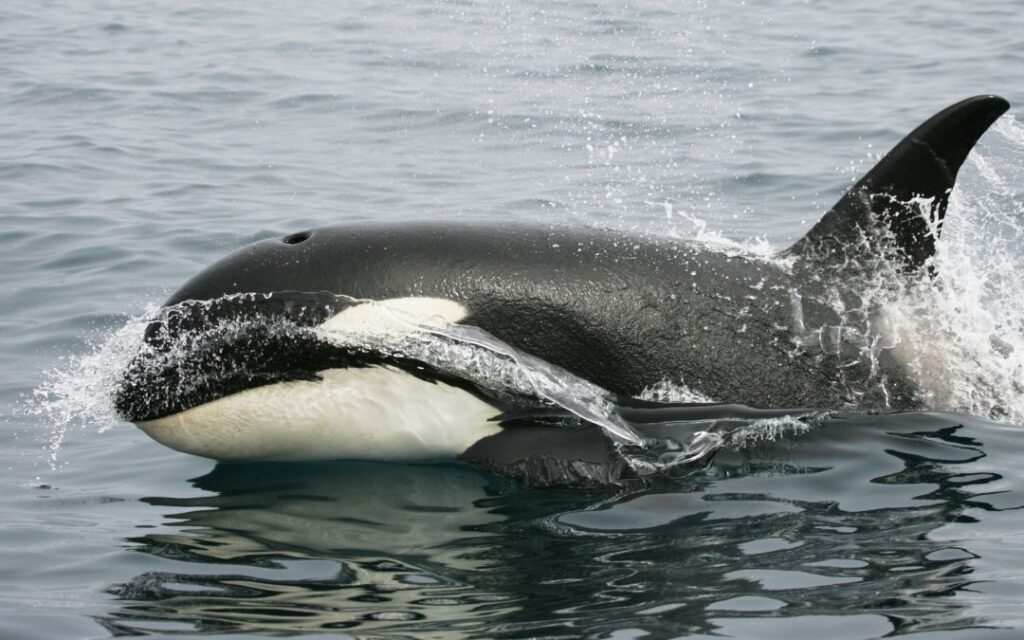Imagine gliding across the vast Pacific Ocean, when suddenly you spot a pod of majestic orcas. These powerful creatures are swimming gracefully, but something seems unusual. Some of them appear to be wearing strange headgear—dead salmon balanced atop their heads. This peculiar behavior, which had vanished for over 40 years, has resurfaced, almost like a scene from a bizarre nature documentary.
The Return of the Salmon Hat Tradition

Orcas, also known as killer whales, are famous for their intelligence and complex social structures. However, scientists are both intrigued and puzzled by the recent return of the “salmon hat” behavior. Orcas off the Pacific Northwest coast have once again been observed balancing dead salmon on their heads—an odd custom first spotted in the 1980s and thought to have disappeared since then. But now, it’s back. What does this behavior mean? Is it a social tradition, a playful act, or something completely beyond human comprehension?
While the reasons behind this phenomenon remain unclear, it provides a rare glimpse into the fascinating and mysterious world of orcas.
The Strange Salmon Hat Phenomenon
Orcas are no strangers to unusual behaviors, but the “salmon hat” is one of the most baffling. In this behavior, orcas swim for long periods with dead salmon placed delicately on their heads. Observers note that the fish seem to be positioned with intent, suggesting purpose rather than randomness.
Marine biologists find this behavior intriguing, especially since it doesn’t appear to have any direct practical benefit, unlike their typical hunting or feeding activities. “It’s possible that some orcas who experienced this behavior in the past may have revived it,” said orca behavior expert Andrew Foote. This raises intriguing questions: Is this a playful activity, a form of social bonding, or perhaps a cultural display specific to certain pods?
The resurgence of this behavior among orcas in the Pacific Northwest suggests there may be deeper social or cultural significance to this quirky habit, though not all orca populations seem to practice it.
A 37-Year Hiatus: Why Did It Disappear?

The “salmon hat” behavior was first noted in the 1980s, but after a short period of curiosity, it mysteriously vanished, leaving scientists puzzled. Now, almost 40 years later, it has made an unexpected comeback. Marine biologist Deborah Giles remarked, “It’s been a while since I’ve personally seen it,” underscoring the rarity of this behavior.
The question now is whether the current generation of orcas has rediscovered and adopted this tradition, or if certain individuals or pods have preserved it all along. Some biologists speculate that environmental changes or shifts in prey availability might have contributed to the behavior’s decline. Others believe that younger orcas may be imitating older generations, reviving an old social custom.
Play, Social Bonding, or Cultural Tradition?
Theories abound about why orcas engage in this strange behavior. Orcas are known for their sociability and playfulness, often engaging in activities that don’t directly contribute to survival. The “salmon hat” could be a form of complex play, a way for orcas to bond, or even a way to demonstrate skill within the pod.
Giles suggests that it could be a playful bonding activity, much like how dolphins interact with seaweed or bubbles. On the other hand, it might also serve as a display of agility, a way to assert dominance or proficiency within the pod. Some scientists speculate that it could even have symbolic or ritualistic meaning, passed down through generations as a form of cultural expression.
The return of this behavior after decades of dormancy highlights the remarkable capacity of orcas to preserve and pass on cultural knowledge. Researchers are eager to understand the nuances of orca social life as they continue to observe this curious phenomenon.
Cultural Transmission and Orca Society

The resurgence of the salmon hat behavior sheds light on the complex cultural dynamics of orca pods. Orcas, much like humans, have the ability to learn and pass down behaviors through social interactions—a process known as cultural transmission.
Orcas are known for their diverse learned behaviors, from unique vocal languages to specialized hunting techniques adapted to their environment. The revival of the “salmon hat” tradition, after such a long gap, speaks to the sophistication of orca culture and memory.
Whether this behavior was passed down through established traditions or rediscovered by younger orcas experimenting with old customs, it serves as evidence of the intricate social structures that define orca communities.
The Future of Orca Research and Conservation
The resurgence of the “salmon hat” trend offers a rare opportunity to learn more about orca behavior, revealing new insights into their social lives, intelligence, and cultural transmission. This phenomenon encourages scientists to look beyond traditional research on hunting and migration, focusing more on understanding the social and cultural dynamics of these marine mammals.
Perhaps the most fascinating aspect of the “salmon hat” behavior is its potential connection to the orca’s extraordinary ability to preserve cultural knowledge. The long gap between occurrences raises the possibility that orcas maintain certain behaviors in their “cultural repertoire,” which they can reactivate under the right circumstances.
This discovery has important implications for how we view orcas’ cognitive and social abilities. It also reinforces the need for marine conservation efforts. By understanding the cultural lives of orcas, we can better protect their habitats and ensure they continue to thrive, preserving the remarkable intelligence and adaptability that these animals display.
In a world where much of the ocean’s mysteries remain unsolved, the return of the “salmon hat” fad reminds us of the incredible depths of knowledge still waiting to be uncovered. Orcas continue to fascinate us, and their ability to preserve and pass on cultural practices only adds to their allure. As we focus on their conservation, we gain not only a deeper understanding of these magnificent creatures but also valuable insights into the intricate web of life beneath the ocean’s surface.
Lucky Colors for the 12 Zodiac Signs
Each zodiac sign has specific colors that can help amplify positive energy, bring good luck, and boost self-confidence. Here are the lucky colors for each sign:
♈ Aries (March 21 – April 19)
🔥 Lucky Colors: Red, Orange, Scarlet
🔺 Why? These bold and fiery colors enhance Aries’ passion, courage, and leadership abilities.
♉ Taurus (April 20 – May 20)
🌿 Lucky Colors: Green, Pink, Earthy Tones
🔺 Why? Green symbolizes growth and stability, while pink fosters love and harmony.
♊ Gemini (May 21 – June 20)
💛 Lucky Colors: Yellow, Light Green, White
🔺 Why? These vibrant colors boost Gemini’s communication skills, creativity, and adaptability.
♋ Cancer (June 21 – July 22)
🌊 Lucky Colors: Silver, White, Light Blue
🔺 Why? These calming colors reflect Cancer’s emotional depth, intuition, and lunar connection.
♌ Leo (July 23 – August 22)
☀️ Lucky Colors: Gold, Orange, Yellow
🔺 Why? These regal and radiant hues emphasize Leo’s charisma, confidence, and strength.
♍ Virgo (August 23 – September 22)
🌾 Lucky Colors: Green, Brown, Beige
🔺 Why? Earthy tones enhance Virgo’s practicality, wisdom, and sense of order.
♎ Libra (September 23 – October 22)
🎀 Lucky Colors: Pink, Blue, Pastel Shades
🔺 Why? These soothing colors promote Libra’s balance, love, and diplomatic nature.
♏ Scorpio (October 23 – November 21)
🖤 Lucky Colors: Black, Dark Red, Burgundy
🔺 Why? These deep shades reflect Scorpio’s mystery, intensity, and transformative energy.
♐ Sagittarius (November 22 – December 21)
💜 Lucky Colors: Purple, Royal Blue, Dark Yellow
🔺 Why? These colors highlight Sagittarius’ adventurous, spiritual, and optimistic personality.
♑ Capricorn (December 22 – January 19)
🖤 Lucky Colors: Black, Gray, Dark Green
🔺 Why? These shades mirror Capricorn’s discipline, ambition, and grounded energy.
♒ Aquarius (January 20 – February 18)
🔵 Lucky Colors: Blue, Electric Blue, Silver
🔺 Why? These colors enhance Aquarius’ creativity, originality, and future-oriented mindset.
♓ Pisces (February 19 – March 20)
🌊 Lucky Colors: Sea Green, Lavender, Aqua
🔺 Why? These serene colors boost Pisces’ creativity, intuition, and emotional depth.
Incorporating these lucky colors into your wardrobe, accessories, or environment can help attract positivity and success! 😊✨